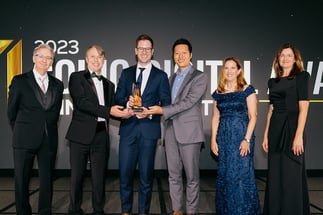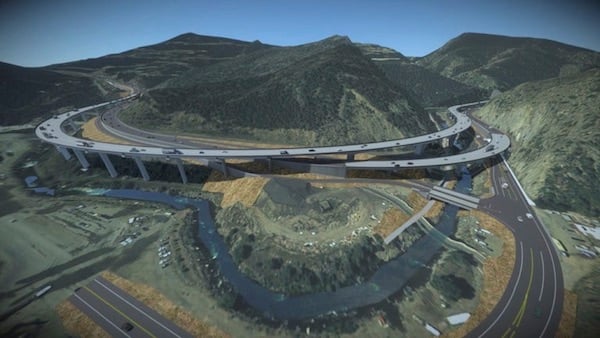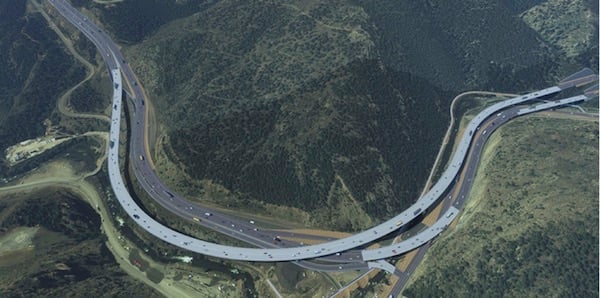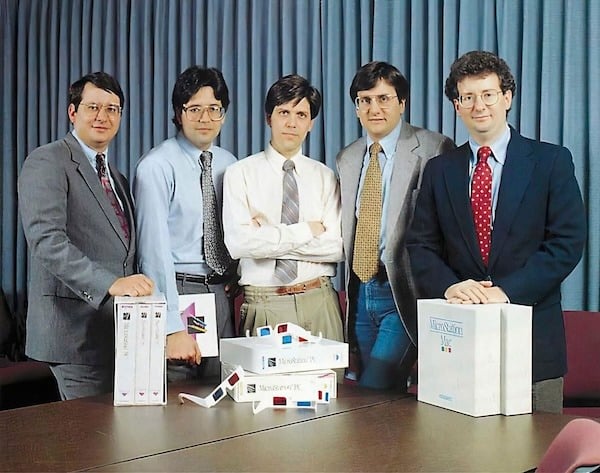The winners of the Going Digital Awards Roads and Highways category take to the stage, from left to right, Greg Bentley (Chief Executive Officer), Dustin Parkman (VP Transportation), winners Alan Carter and S.Y. Liu of AtkinsRéalis, Meg Davis (Enterprise Marketing Director), and Kristin Fallon (Chief Marketing Officer). Image source: Bentley Systems.
At first glance, the task of realigning a busy segment of Colorado interstate highway might seem as daunting as the mountains surrounding the project corridor. With challenging topography, tight site constraints, myriad environmental considerations, and a wide range of stakeholders, designers of the I-70 Floyd Hill project faced complex, ambitious objectives. The project called for numerous upgrades to improve traffic flow, access, and sight distance while replacing aging infrastructure in a spectacular natural setting.
With the help of digital technology, the design team was able to successfully tackle the gargantuan task, while achieving significant time and cost savings in the process. The successful endeavor helped the project’s lead designers, AtkinsRéalis, win the award for the top project in the Roads & Highways category at the Year in Infrastructure and Going Digital Awards, hosted by Bentley Systems, Incorporated in Singapore, October 11–12.
Complex Upgrade
The project owner, the Colorado Department of Transportation (CDOT), was seeking to enhance safety and mobility along the route, as well as rebuild pavement, bridges, and other infrastructure components. The 8-mile project, approximately 25 miles west of Denver, required numerous design disciplines to interact and present various alternatives to the client and the public. Digital technology enabled the team to create realistic models as the design progressed and share design progress throughout the course of the project.
“It’s a very visible project,” said Alan Carter, project manager and lead roadway designer for AtkinsRéalis. “We have a lot of eyes on the project, people interested in what we’re doing. Being able to show the models was essential for public coordination.”
Among the design challenges was adding a third westbound I-70 travel lane to relieve a two-lane bottleneck, not an easy task, given the mountainous topography and a creek that runs along much of the roadway. The new design elevates a portion of the new westbound lanes on bridge structures to fit all the components into a tight space and flatten out some previously sharp curves.
Using Bentley’s OpenRoads Designer for geometric design, OpenBridge Modeler for bridge modeling, LumenRT for visualization, ProjectWise for file management, and various other Bentley tools for discipline-specific tasks, the AtkinsRéalis team built a 3D model of the entire project that could be shared in various formats, including both still images and video flythroughs.
This rendering shows the I-70 Floyd Hill project’s Central Section looking south. Image source: AtkinsRéalis. Click image to enlarge.
“The tools allowed us to create 3D models quickly and evaluate geometrics and specific parameters such as sight distance,” said Carter. “We could attend meetings with stakeholders and fly around the model to get a sense of what the project will look like.”
The design also called for constructing a missing 2-mile section of frontage road, improving ramps and other access points, and upgrading a greenway trail. Environmental mitigation work included two new wildlife passageways underneath bridge spans to connect previously separated natural areas. Various other measures were taken to improve air and water quality, stream conditions, and recreation in the corridor.
Multi-discipline Team
With various design disciplines working on the project, the compatibility of Bentley tools played a key role in the success of the project, according to S.Y. Liu, AtkinsRéalis digitalization manager. “Having a suite that could talk to each other was key,” he said. “We saw the benefits very quickly. We could generate the latest models in a format that people could easily understand. Knowing that what was shown on the screen as a 3D model is the same as the drawing being submitted gave our engineers confidence that what was designed is reflected in the model.”
Working in a connected digital environment also saved time and money. The team estimates that they saved over $1 million managing more than 1,000 file sheets, including 5,500 hours in coordination time, and 97% of effort developing and publishing digital twins for review. The all-digital approach enabled the team to more clearly convey design intent, foster community integration, and quickly update models to mitigate environmental and social impact.
Visualizations played a key role in gaining stakeholder buy-in on the I-70 project. Image source: AtkinsRéalis. Click image to enlarge.
Construction of the $700 million project started earlier this year, and is scheduled for completion in 2028. Contractor Kraemer North America is building the project in three segments, with construction starting at the east end and generally progressing westward, with some schedule overlapping of the three segments.
Looking ahead, Carter sees many opportunities to apply the knowledge of digital technology gained on the project. “We’ve learned how to use the full power of these tools, but we’re just getting started. There’s a lot to be done on the BIM side of things, with digital twins,” he said. The team used Bentley’s iTwin Experience primarily as a review tool to share model information with the client and team participants. In the future, Carter anticipates leveraging additional capabilities to manage project data. “There’s a whole other world, starting with asset management, tagging elements and pay items, and automating quantities,” he said.
Liu added that data sensors and other technology will be used to monitor facility performance on this and future projects. “Understanding all that data and analyzing it to improve the [facility operation] is very exciting,” he noted.

Carter and Liu share highlights of the project at YII. Image source: Bentley Systems.
Other Road & Highway Finalists
Other finalists in the Roads & Highways category included the Hengyang-Yongzhou Expressway in Hunan, China, and the Montrose Interchange project in Mbombela, Mpumalanga, South Africa.
The Hengyang-Yongzhou Expressway is a 105.2-kilometer corridor designed to improve traffic conditions and shorten travel times between the two cities, achieving industrial collaboration and better accessibility along the tourist route. Located amid prime farmland, the project presented environmental, technical, and coordination challenges among the multiple disciplines, districts, and counties. The project designers, Hunan Provincial Communications Planning, Survey & Design Institute Co., Ltd., applied Bentley’s open, integrated 3D BIM and reality modeling applications to provide unified data compatibility.
The digital model and design of the roadway alignment helped minimize impact to farmland by 10 hectares. By comparing on-site point cloud data in OpenRoads Designer, the team eliminated the need for three bridges, saving CNY 40-million in costs. Through collaborative digital design and data integration, the team improved communication efficiencies by 50% and avoided 20 on-site construction errors, saving CNY 5-million. Leveraging Bentley’s BIM solutions, the project is expected to be open to traffic one year ahead of schedule.
The Montrose Interchange project was initiated to replace an existing at-grade T-junction on the N4 highway, improving traffic mobility, safety, and the local economy and tourism opportunities. Located between two rivers amid steep valleys between mountains, the project presented designers SMEC South Africa with difficult terrain for implementing the new high-standard, free-flow interchange. The project was also on a short timeline with no available survey data.
SMEC used iTwin Capture Modeler to develop a reality mesh of the existing terrain and infrastructure and LumenRT to present their conceptual design, winning the design contract and delivering a workable design in record time. OpenRoads Designer facilitated integration with the bridge team’s modeling software while corridor modeling tools enabled accurate earthwork and material quantity calculations. Working in a collaborative digital environment saved approximately 2,500 hours in design time and an estimated ZAR 2.5-million in design costs.
These three unique projects with significant design challenges demonstrate how digital technology can help address mounting infrastructure needs around the world. One can only ponder if these projects could even be attempted without the digital tools.
Watch the Interview
Hear more about the project directly from the winners. Cadalyst managing editor, Lara Sheridan, sat down with Alan Carter and S.Y. Liu in Singapore.








Searching for more information about Architecture, Infrastructure, and Construction?
Click here!